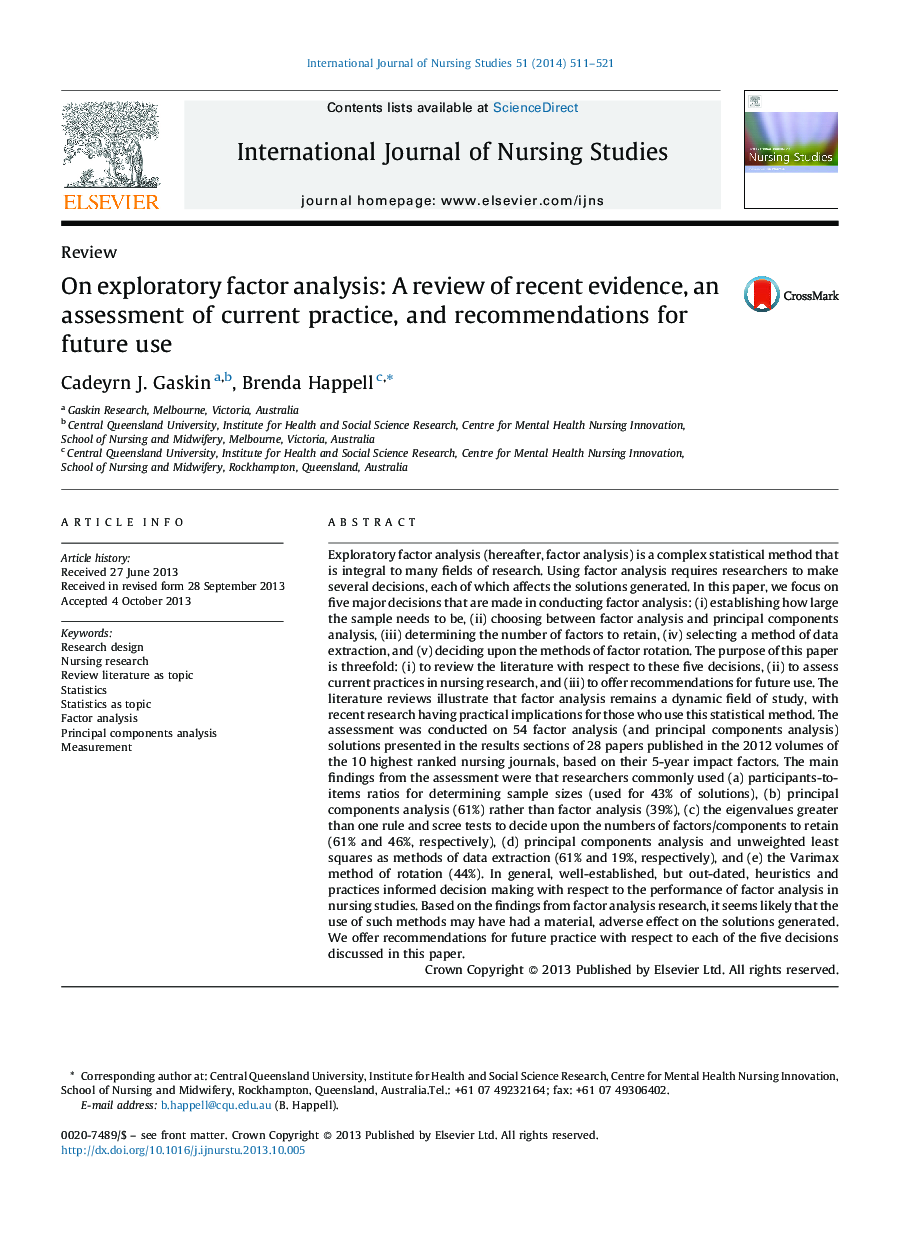| کد مقاله | کد نشریه | سال انتشار | مقاله انگلیسی | نسخه تمام متن |
|---|---|---|---|---|
| 7516064 | 1486538 | 2014 | 11 صفحه PDF | دانلود رایگان |
عنوان انگلیسی مقاله ISI
On exploratory factor analysis: A review of recent evidence, an assessment of current practice, and recommendations for future use
ترجمه فارسی عنوان
در تجزیه و تحلیل عامل اکتشافی: بررسی شواهد اخیر، ارزیابی عمل جاری و توصیه هایی برای استفاده در آینده
دانلود مقاله + سفارش ترجمه
دانلود مقاله ISI انگلیسی
رایگان برای ایرانیان
کلمات کلیدی
طرح پژوهش، تحقیقات پرستاری، بررسی ادبیات به عنوان موضوع، آمار، آمار به عنوان موضوع، تجزیه و تحلیل فاکتور، تجزیه و تحلیل اجزای اصلی، اندازه گیری،
موضوعات مرتبط
علوم پزشکی و سلامت
پزشکی و دندانپزشکی
سیاست های بهداشت و سلامت عمومی
چکیده انگلیسی
Exploratory factor analysis (hereafter, factor analysis) is a complex statistical method that is integral to many fields of research. Using factor analysis requires researchers to make several decisions, each of which affects the solutions generated. In this paper, we focus on five major decisions that are made in conducting factor analysis: (i) establishing how large the sample needs to be, (ii) choosing between factor analysis and principal components analysis, (iii) determining the number of factors to retain, (iv) selecting a method of data extraction, and (v) deciding upon the methods of factor rotation. The purpose of this paper is threefold: (i) to review the literature with respect to these five decisions, (ii) to assess current practices in nursing research, and (iii) to offer recommendations for future use. The literature reviews illustrate that factor analysis remains a dynamic field of study, with recent research having practical implications for those who use this statistical method. The assessment was conducted on 54 factor analysis (and principal components analysis) solutions presented in the results sections of 28 papers published in the 2012 volumes of the 10 highest ranked nursing journals, based on their 5-year impact factors. The main findings from the assessment were that researchers commonly used (a) participants-to-items ratios for determining sample sizes (used for 43% of solutions), (b) principal components analysis (61%) rather than factor analysis (39%), (c) the eigenvalues greater than one rule and scree tests to decide upon the numbers of factors/components to retain (61% and 46%, respectively), (d) principal components analysis and unweighted least squares as methods of data extraction (61% and 19%, respectively), and (e) the Varimax method of rotation (44%). In general, well-established, but out-dated, heuristics and practices informed decision making with respect to the performance of factor analysis in nursing studies. Based on the findings from factor analysis research, it seems likely that the use of such methods may have had a material, adverse effect on the solutions generated. We offer recommendations for future practice with respect to each of the five decisions discussed in this paper.
ناشر
Database: Elsevier - ScienceDirect (ساینس دایرکت)
Journal: International Journal of Nursing Studies - Volume 51, Issue 3, March 2014, Pages 511-521
Journal: International Journal of Nursing Studies - Volume 51, Issue 3, March 2014, Pages 511-521
نویسندگان
Cadeyrn J. Gaskin, Brenda Happell,
